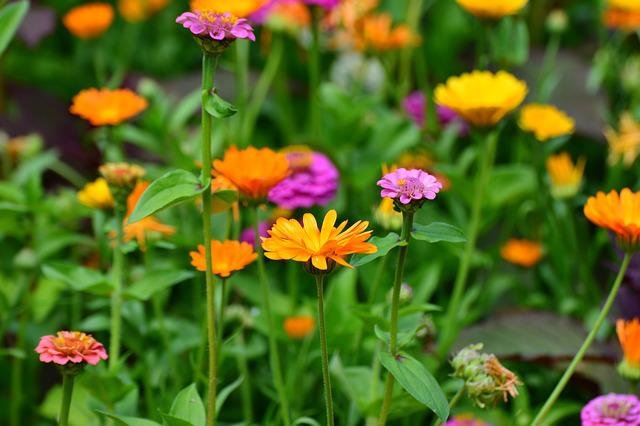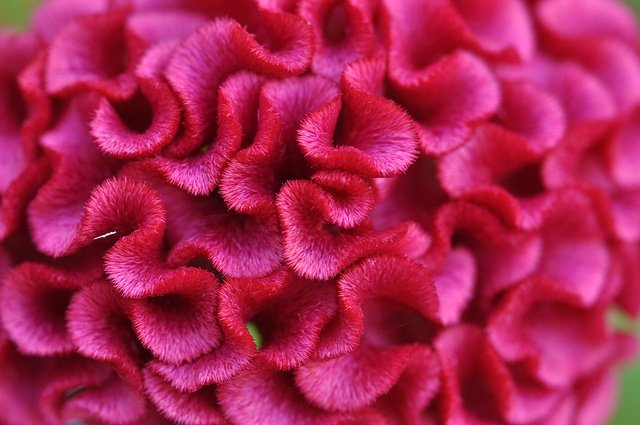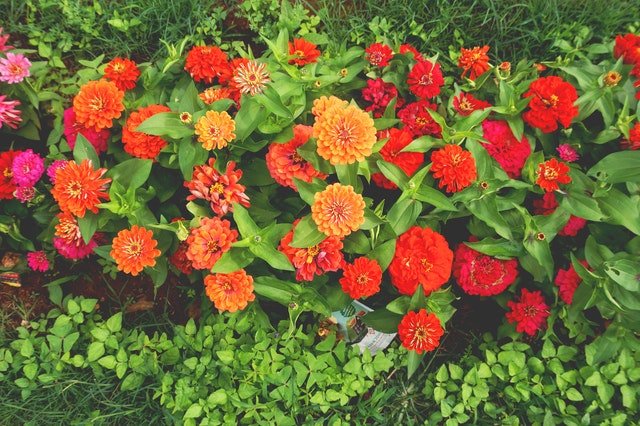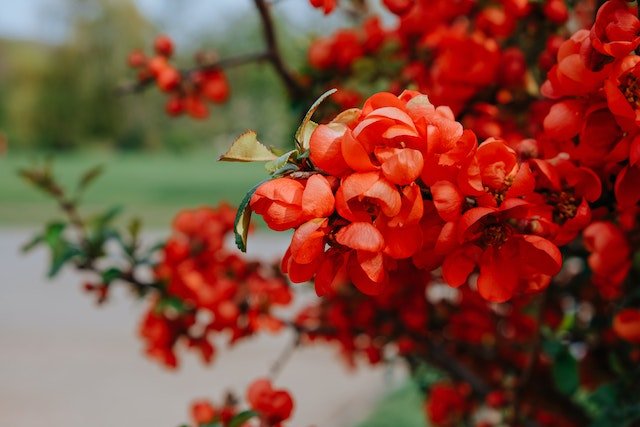Keys Takeaways
- Plant pachysandra in early spring or fall. The ideal soil temperature for planting is between 60-65°F. Avoid summer planting.
- Prepare the soil. Pachysandra thrives in loose, humus-rich soil. Add compost and mix in evenly to a depth of 6-8 inches.
- Space plants 6-12 inches apart. Allow enough room between plants for the rhizomes to spread.
- Water frequently after planting. Keep the soil moist but not saturated until plants are established.
- Mulch to retain moisture. Apply 2-3 inches of shredded bark, leaves, or pine needles around plants.
- Fertilize in spring and mid-summer. Use a balanced organic fertilizer or an acid-based fertilizer formulated for ericaceous plants.
- Divide overgrown patches. Lift, separate, and replant rhizome sections to expand pachysandra beds.
- Cut back old foliage in late winter. Pruning before new growth begins keeps plants looking tidy.
Table of Contents
When to Plant Pachysandra
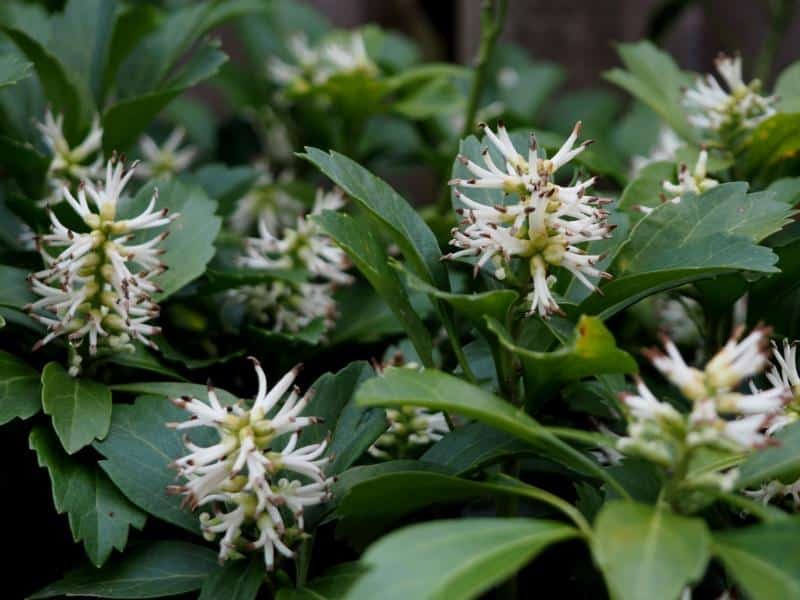
Pachysandra is best planted in either early spring or fall when temperatures are cool. Ideal soil temperature for planting pachysandra rhizomes is 60-65°F.
Spring planting should occur after the threat of hard frost has passed. Plant in March-May depending on your climate zone.
Fall planting should take place 6-8 weeks before first expected frost. Plant in September-October to give plants time to establish roots before winter dormancy.
Avoid planting pachysandra in the heat of summer or during a cold winter freeze. Extreme temperatures increase transplant stress and shock.
Preparing Soil for Pachysandra
Pachysandra thrives in loose, humus-rich soil with a slightly acidic pH between 5.5-6.5. The rhizomes spreads best in soil that is well-draining but moisture retentive.
Prior to planting, work 2-3 inches of compost into the top 6-8 inches of native soil. Compost improves drainage in heavy soils and increases moisture retention in sandy soils.
Also mix in a balanced organic fertilizer like 8-8-8 or 10-10-10 as per label instructions. Rake smooth and level the soil bed. Dig holes for rhizomes 6-12 inches apart across the bare soil.
Plant Spacing for Pachysandra
When planting pachysandra, allow adequate spacing between plants for the rhizomes to spread easily. Spacing pachysandra too far apart results in sparse growth while overcrowding prevents proper spreading.
Follow these spacing guidelines:
- 6-8 inches apart for very quick dense growth
- 8-10 inches apart for normal growth habit
- 10-12 inches for slower spreading over time
Plant pachysandra at triangle points 6-12 inches apart across soil beds. Place the rhizomes just beneath the soil surface and firm the soil around them.
Watering Newly Planted Pachysandra
Consistent moisture is key to establishing newly planted pachysandra beds. Water immediately after planting and as needed to keep the soil evenly moist but not saturated.
During the first summer, water 2-3 times per week on hot, dry days. Pachysandra has shallow roots and needs frequent watering when first planted.
After the first year, a deep weekly watering is usually sufficient for established plants. Supplement with occasional additional watering during droughts.
Also check soil moisture 1-2 inches below the surface before watering. Water when the top few inches become dry. Avoid overwatering.
Using Mulch in Pachysandra Beds

Applying 2-3 inches of organic mulch around pachysandra plants helps conserve soil moisture and suppress weeds.
Good mulch choices include:
- Shredded bark
- Leaf litter
- Pine straw
- Wood chips
The mulch layer should allow rainfall and watering to penetrate easily. Reapply additional mulch as needed, typically 1-2 times per year.
Keeping mulch a few inches away from pachysandra plant crowns prevents potential rot. Rake back excess mulch buildup if it piles too high.
Fertilizing Pachysandra
Fertilize pachysandra at least twice per year to support healthy growth and spread. Use either a balanced organic fertilizer or one formulated specifically for acid-loving plants.
When to fertilize:
- Early spring when new growth begins
- Mid-summer (July/August)
How much to apply: Follow product label rates. For general organic fertilizer, use 1/2 to 1 lb per 100 sq ft.
Spread fertilizer evenly over the soil surface surrounding plants. Water after application to help dissolve the fertilizer and carry nutrients to plant roots.
Dividing Overgrown Pachysandra Patches
As pachysandra beds become overcrowded, divide them to spur faster spreading and expand coverage. Dividing overgrown patches also helps rejuvenate old plantings.
Here’s how to divide and replant pachysandra:
- Cut around edge of bed section with shovel/spade
- Lift and flip over pachysandra section
- Separate rhizomes with hands or knife
- Cut rhizomes into smaller sections
- Replant sections 6-12 inches apart
Aim for pachysandra divisions about 6 inches long. Discard any diseased looking rhizomes. Replant divisions following the soil preparation and planting guidelines above.
Cutting Back Pachysandra Foliage
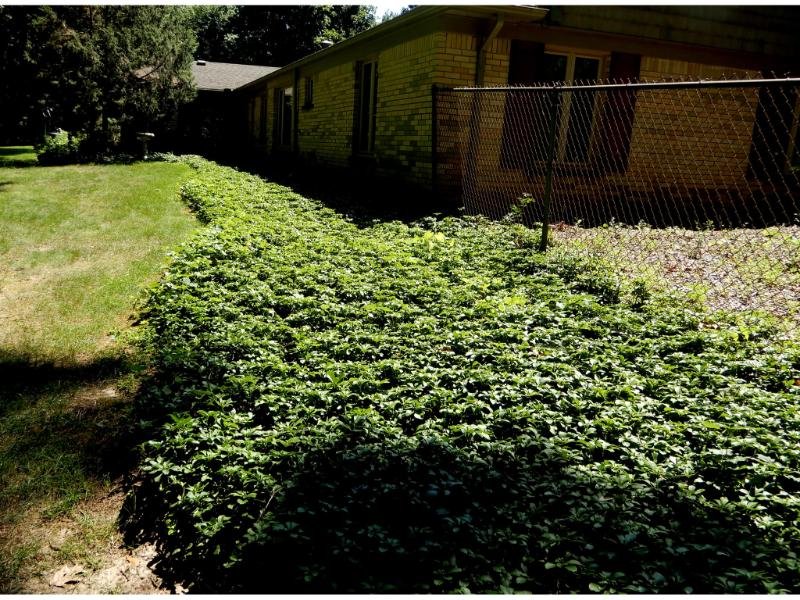
Pachysandra benefits from cutting back old foliage before new spring growth emerges. Pruning keeps plants looking fresh and discourages disease.
Here are a few tips for cutting back pachysandra:
- Use pruning shears for smaller beds or lawnmower/weed trimmer for larger plantings.
- Prune back foliage to 2-3 inches above the ground in late winter or early spring.
- Remove any dead/damaged leaves and stems at any time to improve appearance.
- Disinfect tools with diluted bleach between cuts to prevent spreading disease.
- Rake up and dispose of foliage clippings if excessive.
How Pachysandra Spreads
Pachysandra spreads from below ground rhizomes that grow horizontally outward from the plant base. The rhizomes sprout new shoots and roots that develop into full plants over time.
Under ideal growing conditions, pachysandra rhizomes can spread 6-12 inches per year on average. However, the rate depends on several factors:
Growing Conditions Affecting Spread Rate
- Soil – Loose, fertile soil enables faster rhizome growth.
- Moisture – Consistent watering, good drainage, and mulch mean optimal spread.
- Sun – Dappled or partial shade supports vigorous growth. Too much sun causes stress.
- Spacing – Plants spaced closer together (<8 inches apart) spread faster to fill in gaps.
- Temperature – Cool weather in spring and fall allows the best rhizome growth.
- Division – Dividing and replanting accelerates spreading.
- Weed Control – Removing weeds reduces competition for resources.
Troubleshooting Slow Spreading
If your pachysandra isn’t spreading vigorously, evaluate the growing conditions and care regimen:
- Soil may be too compacted, infertile, or draining poorly.
- Plants may be spaced too far apart to spread well. Space 6-8 inches apart.
- Extreme heat and drought stress can inhibit spread. Water and mulch.
- Too much shade or sun exposure can limit growth. Find the sweet spot.
- Weeds might be competing for resources. Keep beds weed-free.
- Fertilize regularly and divide overgrown areas to rejuvenate.
With good soil preparation, planting, optimal care, and time, pachysandra will spread into a beautiful lush carpet.
Ideal Growing Conditions for Pachysandra
Pachysandra thrives under certain growing conditions and environmental factors. Meeting its preferences is key to success with this classic groundcover plant.
Sun Exposure
Pachysandra grows best in light to medium shade or dappled sunlight. 3-5 hours of morning or late day sun is ideal.
Too much direct sun, especially hot mid-day sun, leads to sunburn, yellowing leaves, and poor spread. Areas with only 1-2 hours of sunlight can result in sparse, leggy growth.
Generally northern exposures or light shade under high tree canopies offer great pachysandra habitat. Avoid hot, dry locations with reflected sunlight.
Soil Needs
Pachysandra prefers fertile, humus-rich soil with a slightly acidic pH between 5.5-6.5. Nutrient-poor or alkaline soils may hinder spread.
To prepare soil, mix in 2-3 inches of compost and an organic fertilizer when planting. Good drainage is also important to prevent root rot.
If native soil tends to be compacted clay or very sandy, amend with compost to improve texture and water retention.
Moisture Requirements
While tolerant of short periods of dryness once established, pachysandra thrives with consistent moisture.
Water regularly, especially in drier conditions, to keep soil lightly moist 1-2 inches below the surface. Avoid oversaturated soil.
Apply mulch to conserve soil moisture. Check moisture before watering and don’t waterlog the soil.
Climate Conditions
Pachysandra is hardy in USDA zones 4-9 and can tolerate cold winters and summer heat in much of the country. Optimal climates align with its native woodland habitat.
Pachysandra flourishes in the cool, humid conditions found in Mid-Atlantic and Midwest forests. Hot and arid climates may require more shade and irrigation.
Spring and fall offer the best growing conditions for pachysandra. Summer heat and winter cold extremes can inhibit spread.
Propagating Pachysandra
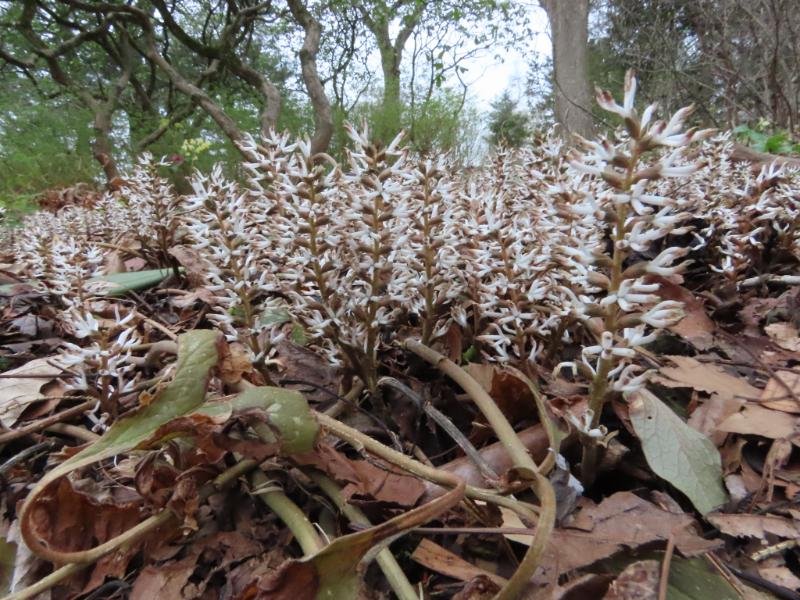
Pachysandra is easy to propagate through division, cuttings, or rhizome sections. Dividing existing plantings allows you to expand and rejuvenate overgrown beds of pachysandra.
Dividing Established Plants
Dividing is the most straightforward way to get more pachysandra plants for free. Here are simple steps:
- Cut around edge of bed section and lift pachysandra clump.
- Turn upside down and separate rhizomes with hands or knife.
- Cut rhizomes into smaller sections approx. 6 inches long.
- Replant rhizome pieces 6-12 inches apart in prepared soil.
- Follow usual care: water, mulch, fertilize as needed.
Dividing overcrowded pachysandra helps stimulate faster spreading. Replant bare root divisions right away before they dry out.
Rooting Stem Cuttings
Rooting stem cuttings of pachysandra is easy. For best results:
- Take 3-4 inch cuttings in spring from new growth.
- Remove lower leaves and dip cut end in rooting hormone.
- Stick into potting mix of half peat and half perlite.
- Cover the pot with a plastic bag to maintain humidity.
- Keep the mix evenly moist but not wet.
- Roots should develop in 4-8 weeks. Transplant into the garden.
Taking cuttings from healthier plants, using rooting hormone, and maintaining humidity improves success rate.
Planting Rhizome Sections
You can propagate pachysandra by planting rhizome pieces. Follow these tips:
- Dig up and divide rhizomes from existing plants.
- Cut rhizomes into 3-4 inch sections.
- Lay sections horizontally 1-2 inches below the soil surface.
- Space rhizomes 6-12 inches apart in prepared garden beds.
- Keep soil moist until new shoots appear.
This method lets you expand pachysandra in a new area or fill gaps where growth is sparse. Plant rhizomes in early spring or fall.
Tips for Growing Healthy Pachysandra
Follow these handy tips and tricks for successfully growing pachysandra groundcover:
Spring Care
- Fertilize with an acid-based plant food when growth resumes.
- Prune out any dead foliage before new leaves emerge.
- Remove weeds and reapply fresh mulch around plants if needed.
- Divide and transplant any overgrown patches to expand beds.
Summer Care
- Water 1-2x weekly during hot, dry spells to maintain moist (not wet) soil.
- Apply additional fertilizer in mid-summer for vigorous growth.
- Clip off flower stems to promote spreading (optional).
- Watch for pests like spider mites and treat with insecticidal soap spray if found.
Fall Care
- Continue watering until hard frost to keep the soil slightly moist.
- Plant any new pachysandra beds at least 6-8 weeks before winter.
- Mulch beds with 2-3 inches of shredded leaves or bark to conserve moisture.
Winter Care
- Avoid walking on frozen plants and allow foliage to remain over winter to protect crowns.
- Remove excessive snow loads that could smother the plants.
- Hold off on dividing/replanting until spring after the threat of frost has passed.
Common Pachysandra Problems and Fixes
When given suitable growing conditions, pachysandra is relatively pest and disease-resistant. However, issues can arise at times.
Yellowing Leaves
Potential Causes: Too much sun, excessive moisture, poor drainage, compacted roots
Fixes: Provide more shade, improve drainage, aerate soil, divide and replant
Leggy Growth
Potential Causes: Insufficient sunlight, nitrogen overfertilizing
Fixes: Increase sun exposure, fertilize less or with a balanced formula
Failure to Spread
Potential Causes: Poor soil, improper spacing, weather extremes
Fixes: Amend soil with compost, divide and replant closer together, mulch, improve care
Withering Foliage
Potential Causes: Underwatering, drought stress
Fixes: Water more frequently, add mulch layer
Mold or Rot
Potential Causes: Overwatering, excessive humidity, poor air circulation
Fixes: Allow soil to partly dry out, increase spacing/airflow, treat foliage with fungicide
Insect Pests
Potential Causes: Spider mites, thrips, aphids, scales
Fixes: Hose off foliage, use insecticidal soap, apply neem oil, release ladybugs
Fortunately, pachysandra is not prone to many serious issues, especially with proper site selection and care. Address any problems promptly to maintain plant health.
Frequently Asked Questions about Pachysandra
Get answers to some common questions about growing and caring for pachysandra groundcover:
Does pachysandra spread quickly?
Given optimal growing conditions, pachysandra typically spreads at a rate of 6-12 inches per year. Quicker growth happens when plants are spaced closer together and divided often.
How far apart should pachysandra be planted?
Space pachysandra plants 6-12 inches apart depending on how quickly you want full coverage. Closer spacing of 6-8 inches fills in faster while 10-12 inches apart takes longer to spread and fill in.
Does pachysandra grow well in full sun?
Pachysandra generally does not thrive in full sun. It requires partial shade or dappled sunlight (about 3-5 hours per day ideally). Too much hot sun causes leaf scorch.
Is pachysandra deer resistant?
Deer tend to avoid browsing on pachysandra because of its coarse leaves and semi-evergreen foliage. It is one of the more deer-resistant groundcovers.
Is pachysandra invasive?
Pachysandra spreads vigorously by underground rhizomes but is not considered an invasive plant. It stays where planted and is easy to contain by mowing or digging edges.
What’s the best time to plant pachysandra?
Early spring after the threat of hard frost, or early fall about 6-8 weeks before the first expected frost are ideal times to plant pachysandra. Avoid summer heat or winter cold.
Can pachysandra tolerate some foot traffic?
Pachysandra can tolerate light foot traffic, especially once well-established. But avoid excessive trampling which can damage the shallow roots and compact the soil.
Does pachysandra flower?
Pachysandra produces small white flowers on short spikes in spring but they are not very ornamental. The foliage and spreading carpet effect are its main appeal. Clip off flowers to promote spreading.
Is pachysandra evergreen or deciduous?
Pachysandra is considered semi-evergreen to evergreen. The foliage persists over winter in many climates but plants benefit from cutting back old leaves in late winter before new growth emerges.
Conclusion
With its lush green carpet effect, pachysandra is a go-to groundcover for woodland gardens and shady slopes. Paying attention to ideal growing conditions like fertile soil, partial shade, and consistent moisture enables this tough plant to thrive.
Simple care like spring pruning, summer watering, and fall mulching keeps pachysandra looking fresh. Dividing overgrown areas every few years rejuvenates plantings and accelerates spread.

Gardening is my passion and growing plants indoors has always been a stress relief for me. Grow a banana tree in my apartment once (although failed to produce bananas).


